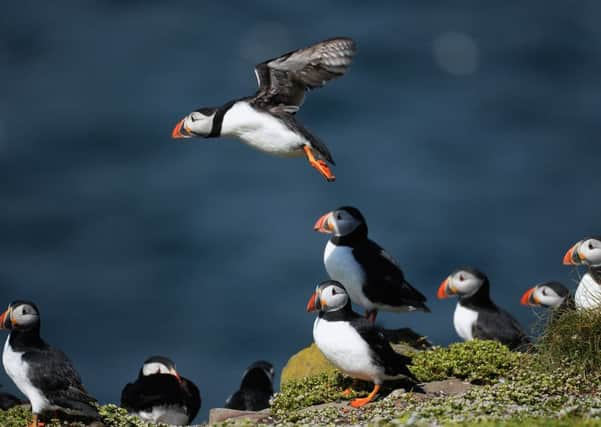Fair Isle in marine bid to shore up bird life


Now, the community in Britain’s most remote inhabited island is seeking the public’s help to have its waters surrounding their home designated the first conservation area of its kind anywhere in Scotland.
Fair Isle, which lies halfway between the Shetland and Orkney archipelagos, is prized around the world for its diverse bird population, with nearly 400 species recorded as part of their migratory patterns.
Advertisement
Hide AdAdvertisement
Hide AdHowever, several species, such as the puffin, kittiwake, guillemot and arctic skua, have endured dramatic population declines since the 1990s.
Seventeen species of seabirds breed on the island and are a major draw for the island’s tourism. Two decades ago, around a quarter of a million birds would visit during the summer months, but by 2010 that number had plummeted to a little over 100,000.
On behalf of the island’s residents, the Fair Isle Marine Environment and Tourism Initiative (Fimeti) wants to see a 5km boundary of its waters recognised as a Demonstration and Research Marine Protected Area (MPA).
Unlike other MPAs, it would specifically be targeted at carrying out research and studies of sustainable methods of marine management, as well as monitoring the impact of climate change. If approved, it would be the first designation of its kind in the country.
Fimeti, a partnership between the community, the Fair Isle Bird Observatory Trust and the National Trust for Scotland, is now calling on people to show their support by taking part in a Scottish Government public consultation that is running until the end of May.
Nick Riddiford, Fimeti’s co-ordinator, said, “I am delighted that 25 years of community effort to safeguard our seas has reached this milestone. Its goal as the first Demonstration and Research MPA in Scotland is to pilot a partnership approach towards sustainable marine management of benefit to all.
“The sea plays a huge role in the economic, social, cultural and environmental wellbeing of the isle. The designation would make a big difference for Fair Isle.”
The National Trust for Scotland, which has owned the island since 1954, said the scheme could well prove to be of international significance.
Advertisement
Hide AdAdvertisement
Hide AdRichard Luxmoore, the trust’s senior nature conservation adviser, explained: “The designation would provide an opportunity for Scotland to demonstrate the value of this novel and innovative form of marine protection to the wider world.”
Fimeti says the entire Fair Isle community – around 55 people – recognises that the fishing industry is vital to Shetland and wants it to prosper. Crucially, its proposal also has the backing of the Shetland Fishermen’s Association.
The association’s chairman, Leslie Tait, said: “We’re quite happy to be part of the steering committee to investigate and come forward with ideas and proposals, but also to listen to others.
“Along with the ecological and socio-economic values the MPA is anticipated to bring, it also has the potential to be an important example of collaborative management within Scottish seas – with the community, commercial fishermen, research institutes and many others all on board.”
Fiona Mitchell, chair of Fair Isle Community Association, added: “The Fair Isle community has long advocated an MPA and we are delighted to see it move into the next stage of public consultation.
“Thanks to islanders, supporters, and new alliances with fishermen, this is an aspiration that has become a reality.”
The Scottish Government public consultation can be found at https://consult.scotland.gov.uk